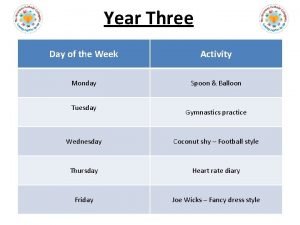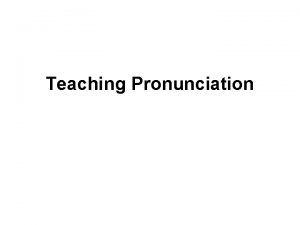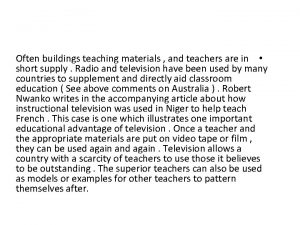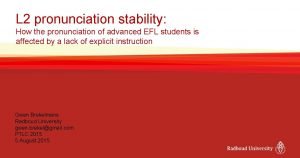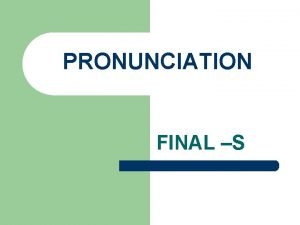Teaching Pronunciation Teachers often shy away from pronunciation















- Slides: 15

Teaching Pronunciation

• ´Teachers often shy away from pronunciation work, yet it is key for students. ´ • ´Pronunciation can be an overlooked area of LT, partly because teachers themselves may feel more uncertain about it than about grammar or lexis, worried that they don´t have enough technical knowledge to help students appropriately. However, when teachers take the risk, they are often surprised to find that it makes for very enjoyable and useful classroom work. ´ (Scrivener, 2011, p. 271)

Pronunciation can be taught in: • whole lessons, dedicated • discrete slots (from time to time) • integrated phrases (on regular basis) • opportunistic teaching – when the moment is opportune, when the students “ask” for that

• The concept of pronunciation • the sounds of the language (vowels and consonants, diphthongs, consonant clusters); • word stress; • weak forms; • connected speech; • sentence stress; • rhythm; • intonation;

• The sounds - the phonemic alphabet • Teaching the phonemic transcription – integral part of the language systems (the language systems x the skills)

• The RP pronunciation - ´received pronunciation´ (south-east England UK variety); typical feature – elisions (comfortable), weak forms, lack of ´r´ sound (car, hard) • English – a lingua franca (a language used to communicate between speakers of different mother tongues);

• Goal of teaching pronunciation – INTELLIGIBILITY - ´being understood by a listener at a given time in a given situation´ aiming at something ´close enough´ (Kenworthy, 1992, p. 13) • The objective – not to achieve a perfect imitation of a native accent, but to get the learners to pronounce accurately enough to be easily and comfortably comprehensible to other speakers. (Ur, 1996, 52);

• Why do learners make pronunciation errors? • A particular sound may not exist in their MT (tendency to substitute by the nearest equivalent known); ! mind the unvoiced ´h ´in English, the aspiration with p, t, k (x b – unaspirated) • A sound does exist in the MT, but not as a separate phoneme (/i/ x / i: / in English and Hebrew, /r / and /l / in English and Korean ; phonemes and allophones) (Ur, 53)

• • • Sources of intelligibility problems sound substitution (My friend is sick x My friend is thick); sound deletion (hold x hole); sound insertions (a-speak); (Kenworthy, 1992, p. 18)

• Connected speech – unstressed syllables tend to have weak vowel sounds, sounds get dropped - elision, sounds get changed assimilation, additional linking sounds occur; (Scrivener, 2011, 282) • links between words (a linking sound – e. g. go in x go win; a sound merger, e. g. nice shoe, a composite sound - e. g. this year) (Kenworthy, 1992, p. 18)

• The use of stress • stressed syllable – noticeable by being slightly louder, longer and higher in pitch –getting the stress wrong can seriously damage your chances of being understood; • e. g. : written x retain, desert x dessert; change of the word class – import x import (N x V) • unstressed syllables – less loudly pronounced, vowels - ´weak´

• Getting the learners to perceive/helping learners hear • The first step – to check that the learner can hear and identify the sounds (intonation, rhythm, stress) we want to teach; • discriminating exercises - seeing if the learners can distinguish between minimal pairs; • the following technique – requesting imitation, contrasting acceptable pronunciation with the inacceptable one through recordings or live demonstration (Ur, 53, Kenworthy, 7);

• The rhythm and stress • English speech rhythm is characterized by tone units (a word or group of words which carries one stressed syllable, with other syllables lightened); • Intonation – (rising or falling, a rise-fall, a fallrise) often makes difference to meaning or implication (speaker´s attitude - can be/sound offensive);

• Prominence – sentence stress: • Utterances consist of tone units - sections of speech with one main stress; the main stress – the tonic syllable (nucleus); utterances include other – secondary stresses; changes in prominence – substantial differences to meaning; • (ex. : Caroline was going to leave for Africa on Tuesday. ) • Advice – Cuisenaire rods, tapping, clapping, humming the rhythm – to make students more aware; • Other suitable sources: poetry, songs, shadow reading – see the seminar handout;

Resources: Scrivener, 2005, Learning Teaching; Kelly, 2000, How to Teach Pronunciation; Kenworthy, 1992, Teaching English Pronunciation; • Ur, 1996, A Course in Language Teaching; • •
 Organizations may shy away from cloud computing because:
Organizations may shy away from cloud computing because: Kim kroll teachers pay teachers
Kim kroll teachers pay teachers Go away spooky ghost
Go away spooky ghost We often go away at weekends
We often go away at weekends Always usually never
Always usually never Attitude of teachers towards teaching profession
Attitude of teachers towards teaching profession Shy glance painting
Shy glance painting Proud to noun
Proud to noun Wheel yum air ream he
Wheel yum air ream he How do you analyze a word's connotation?
How do you analyze a word's connotation? Dr michael shy
Dr michael shy Shy loud
Shy loud 6/a yazısı
6/a yazısı Optimistic shy selfish
Optimistic shy selfish Coconut shy definition
Coconut shy definition Corticobasale degeneratie levensverwachting
Corticobasale degeneratie levensverwachting














